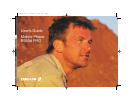
Not for commercial use
– Ericsson Inc.
2 Guidelines for Safe and Efficient Use
Phone Operation
NORMAL POSITION: Hold the phone as you would
any other telephone with the antenna pointed up and
over your shoulder.
TIPS ON EFFICIENT OPERATION: For your phone
to operate most efficiently:
• Extend your antenna fully (where applicable).
• Do not touch the antenna unnecessarily when the
phone is in use. Contact with the antenna affects
call quality and may cause the phone to operate at a
higher power level than otherwise needed.
Driving
Check the laws and regulations on the use of wireless
telephones in the areas where you drive. Always obey
them. Also, if using your phone while driving, please:
• Give full attention to driving – driving safely is
your first responsibility.
• Use handsfree operation, if available.
• Pull off the road and park before making or answer-
ing a call if driving conditions so require.
In addition, Ericsson suggests the following safe driving
tips if you are using your phone while driving:
• Get to know your wireless phone and its features
such as speed dial and redial.
• Position your wireless phone
within easy reach.
• Suspend conversations during
hazardous driving conditions or
situations.
• Do not take notes or look up
phone numbers while driving.
• Dial sensibly and assess the traffic; if possible, place
calls when you are not moving or before pulling
into traffic.
• Do not engage in stressful or emotional conversa-
tions that may be distracting.
• Use your wireless phone to call for help.
• Use your wireless phone to help others in emergen-
cies.
• Call roadside assistance or a special wireless non-
emergency assistance number when necessary.
Electronic Devices
Most modern electronic equipment is shielded from RF
signals. However, certain electronic equipment may not
be shielded against RF signals from your wireless phone.
Pacemakers
The Health Industry Manufacturers Association recom-
mends that a minimum separation of six (6") inches be
maintained between a handheld wireless phone and a
pacemaker to avoid potential interference with the pace-
maker. These recommendations are consistent with the
Ditto Lornetta.book Page 2 Thursday, July 13, 2000 3:55 PM


















